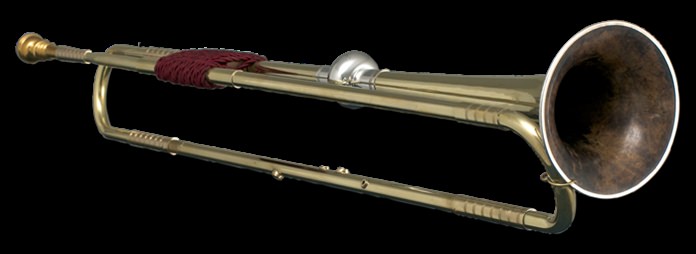
A few evenings ago, someone at the drinking trough was asking how a trumpet can produce so many notes when it has only three valves. It’s a good question. You may recall that a bugle, which has no valves whatsoever, can still produce a sufficient number of notes to perform simple tunes. Of course, it’s all done with the lips. To be more precise, it’s done by blowing into the mouthpiece through nearly-closed lips. This produces a “buzzing” effect which causes the air inside the tube to vibrate. The tube and bell act as amplifiers and a musical note is the result. For this reason, musicologists (but not musicians) refer to brass instruments as labrosones which literally means “lip-vibrated instruments”.
“Well yes”, you might reasonably say, “but where do the different notes come from?” The answer lies in a slightly daunting acoustical concept which occurs in nature and known as the harmonic series. A friend of mine, who played the trombone, was fond of doing his Garden Hose Trick. Using an ordinary hose cut to about five or six feet in length, he’d stick a trombone mouthpiece into one end and a cone-shaped funnel into the other. He would then play a bugle-like tune. He was using the notes of the harmonic series.
Any tube has a fundamental pitch with its own series of harmonics (sometimes called overtones) though they are normally inaudible unless triggered by vibration. As the lips are tightened and more air pressure is applied the lips vibrate faster. The air in the tube also vibrates faster and triggers a higher note of the harmonic series. With careful control of lip tension a bugle player can produce about half-a-dozen different notes. I admit that I have simplified all this considerably, because I can sense your eyes glazing over. But that’s the gist of it.
Like bugles, the earliest trumpets and horns had no valves because they had yet to be invented. The tubes were a fixed length and could use only employ the notes of one particular harmonic series. To access more notes, the length of the tube had to be changed. The only way was to manually insert an extra bit of tubing (known as a crook) which would increase the length of the instrument and thus lower the pitch. But for hundreds of years it was mechanically impossible to do this instantly. The technology was simply not available. The sackbut, which was the ancestor of the trombone got around the problem by using a slide.
It was not until 1818 that a valve design was finally patented. The valves opened extra bits of tubing and thus lowered the pitch of the instrument. By using the valves and valve combination a brass player could produce at least thirty different notes. Incidentally, you might wonder how 18th century trumpet players managed the challenging part in Bach’s second Brandenburg Concerto. It was done by using a high-pitched clarino trumpet on which the player controlled the extreme high notes of the harmonic series purely by the lips. These top harmonics lie close together and composers could use them to make a melody, but they were notoriously difficult to play.
Nobody would be more surprised at hearing this concerto than Tomaso Albinoni himself, for in his day it would have been virtually impossible to play all the notes on a trumpet. The work was originally written for oboe but it fits the modern valve trumpet perfectly. In this performance the soloist uses the so-called piccolo trumpet which has about half the length of tubing than a standard trumpet and is therefore much higher in pitch creating a bright, penetrating sound.
Albinoni was best-known an opera composer and claimed that he wrote over eighty operas though over the years, the scores of most of them have been lost. Ironically, Albinoni is best-known for his Adagio, which is now thought to be partly the work of someone else.
Fast forward two hundred years and drop down a few octaves and we come to this delightful tuba concerto by the British composer Ralph Vaughan Williams. The work dates from 1954 and soon became one of the composer’s most popular works. Although the playing technique of the tuba is similar in principle to that of the trumpet, the instrument lies at the opposite end of the acoustic scale. It’s the largest instrument of the brass family and was invented during the 1830s. The instrument was made in many different sizes and in America it transmogrified into the wrap-around sousaphone, a tuba designed for marching bands.
Listen out for the lovely lyrical slow movement (at 06:40) which oozes the pastoral Englishness for which the music of Vaughan Williams was noted.
 |
 |
 |





